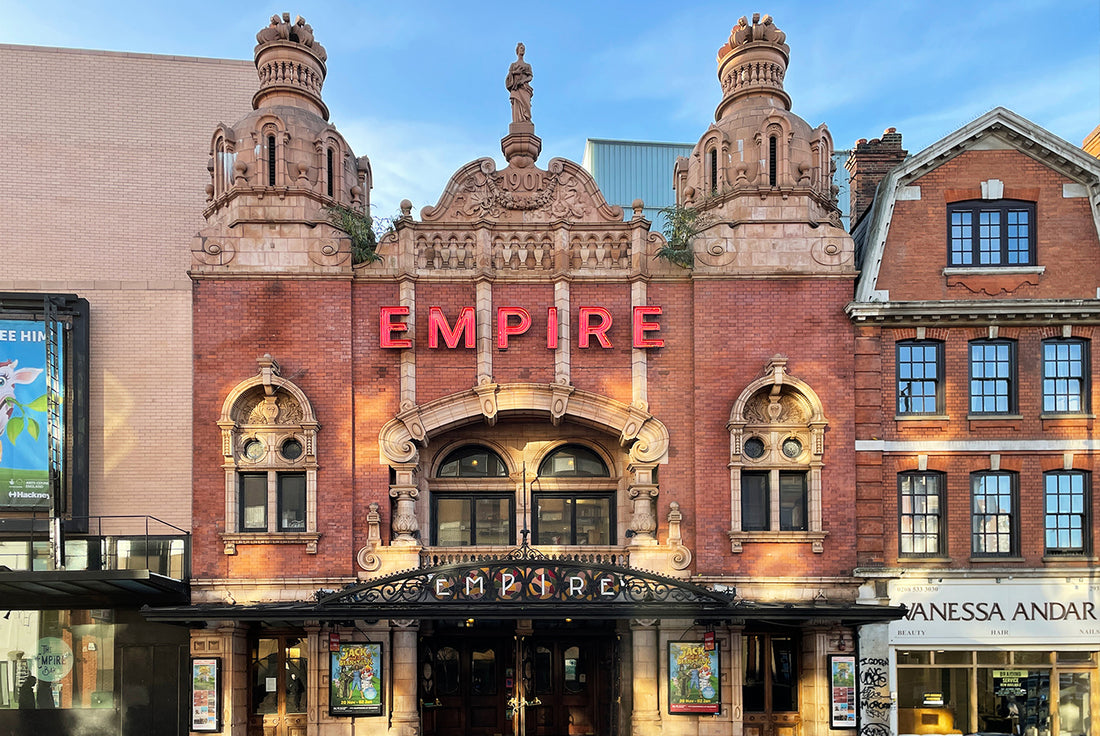
A walking tour of urban typography in Hackney
Share

Join us to visit some locations featured on our new Hackney Type Map. The map highlights historic typefaces in the creative east London borough as seen on the building facades of warehouses, pubs, cinemas and more. London-based author Lilly Marques is a designer working within type and tech across typefaces, art direction and design, and here she guides us from the heart of Shoreditch to Hackney Central.

Tea Building, Shoreditch, E1
Former Tea Warehouse, 1930s. Rooftop stencil lettering
Starting in the heart of East London, Shoreditch – creative tech hub of the city. This iconic building, designed by New Zealand-born architect Hal Williams, served as a tea packing factory from the 1930s until the late 1970s, when Shoreditch was particularly hit hard by the recession. As other vacant warehouses, it was converted to offices and now houses some of the trendiest design companies in London. On the very top is a striking sign that derives from French metal stencil letters, as found on the wooden tea crates arriving here from overseas. A modern representation of lettering use as a guide, as its prominence in the district makes it a point of reference, not only by its name but by its sign.

Wells & Company, Shoreditch, E1
Former warehouse, 1877. Arts & Crafts flush lettering
Walking up Shoreditch High Street for a couple of minutes you will come up to this wonderful sight - former showroom and warehouse built in 1877 for Edward Wells & Co ironmongers. Its attention-grabbing facade features two huge arches and is a beautiful example of tiled lettering weaving throughout the facade. The gothic revival sign runs along both arches, (shame for a part clumsily cut out for a window). Pay notice to the ampersand form, a true delight.

Rio Cinema, Kingsland Rd, E8
Art Deco Cinema, 1950. Art Deco illuminating lettering
As the High Street continues up north in almost straight line, it arrives in Dalston. There stands Rio Cinema – a Grade II listed Art Deco building with over a century of history. The landmark has been a hotspot for Hackney locals, running as a cooperative independent cinema. In 2012 Transport for London changed the name of the bus stop outside to ‘Rio Cinema’ – the ultimate praise. The exterior evolved over time and now hosts a huge acrylic neon box-shaped sign that pays a visual tribute to the heyday of cinema in the 1930s. Magnificent colours at night, lighting the way for locals.

Egg Stores Ltd, Stoke Newington, N16
Originally egg dealing business, 1951. Fat face lettering
Located at the top end of the High street, one of Stoke Newington’s treasured landmarks. The original shop was an egg dealing business, opened in 1951. It has changed hands many times and was even destroyed in a fire, however its wonderful Festival of Britain-era fat face sign was always restored. It now sits as a cultural reference in a village-like part of the borough moments from Stoke Newington Church Street (hosting independent shops and cafes), and the beautiful Clissold Park.

The Pembury Tavern, Hackney Downs, E8
Public House, 1866. Concrete cast relief lettering
Now heading east towards Hackney Central, we arrive at so-called ‘five points’ junction. In one corner stands The Pembury Tavern, a most pleasant pub. In the early 2010s, when East London became the epicentre of small breweries, one such start-up named themselves after this junction – Five Point Brewing. They bought this historic 1866 pub and brewed their beer across the road. At the top of the building are lovely sans relief letterforms, concrete cast with an abundance of character – although rather inconsistent.

Hackney Empire, Hackney Central, E8
Theatre built in 1901. Illuminated lettering (neon outline by night)
At the centre of cultural Hackney is a famous landmark and celebrated theatre, built in 1901, commissioned by Oswald Stoll, prominent theatre producer. It was designed by renowned architect Frank Matcham. One of the first theatres to have electric lights, it is now the only surviving purpose-built theatre in Hackney. Its name is rendered in different materials and styles across the facade, from illuminated letters, stained glass type to cast sign. The typography examples are fitting: a wonderful compilation that shares in Hackney's rich history of creativity.

